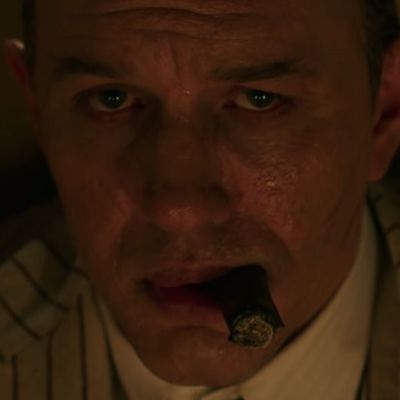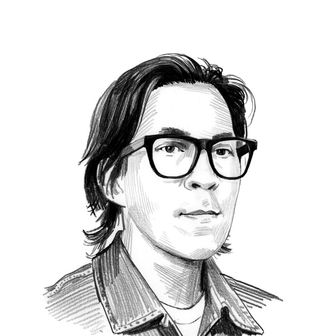
In the dreamy, violent and decidedly weird biographical drama Capone, which arrived on demand earlier this week, Tom Hardy dispenses with any fact-based portrayal of the titular Prohibition-era capo. In writer-director Josh Trank’s imagining of Al Capone’s last year, Hardy plays Scarface as a flatulent, dementia-addled, stroke paralyzed, yet still rage-prone and borderline homicidal lion in winter. In ways both sublime and ridiculous, it’s a kind of post-verbal performance. Employing a syrupy Brooklyn accent and a vocal timbre somewhere between a gargoyle’s rasp and the grizzled cartoon baritone of Popeye the Sailor, the British Oscar nominee barks barely intelligible commands at mob goons and seethes Italian profanities. He warbles his way through the Wizard of Oz comedic Cri de Coeur “If I Were King of the Forest” and alternately browbeats and sweet talks his long-suffering wife May (Linda Cardellini). “You sound like a dying horse,” a mob confrere played by Matt Dillon tells Capone in Capone.
Two decades into a career punctuated by no small number of blockbusters and critical triumphs, Hardy’s oddball vocal characterizations comprise a movie sub-genre unto themselves: his Darth Vader-meets-T-Pain speech pattern in The Dark Knight Rises, the sing-song-y Welsh lilt in 2013’s Locke, his “demented sea lion” affect in Child 44, and the “Toby Keith choking on a Cheeto” Southern accent in Lawless notable among them.
According to Trank, the actor spent months leading up to pre-production on the film perfecting the character’s accent and delivery. “He would send me digital voice notes, trying out different versions of the voice so we could find it together,” says Trank, the embattled Fantastic Four director who mounted the Capone production as a form of personal therapy. “Just like with the acting process, he wants all the feedback. So I would send him anything I thought was helpful. Tom is extremely skilled at keeping himself in control. A century ago, he could have been a circus performer or something. Or a mime. He can make himself seem bigger or smaller by holding his body a certain way. The same goes for his command of his voice. He can do so many different kinds of voices and accents it’s incredible.”
No audio recordings of Capone’s voice are known to exist, although numerous print interviews with the man prominently showcase the “dems” and “dose” of his native Broolynese. Trank’s own research pointed Hardy toward other public figures also hailing from the borough around the turn of the century, particularly the predominantly Italian-American Park Slope neighborhood. “Jimmy Durante — that’s what the accent was,” the director says. “Park Slope Italians — that’s what the accent sounded like.” A certain cartoon voice superstar (who it should be noted was born in San Francisco in 1908) provided a less likely but nonetheless crucial back note for the character’s vocalizations: “You also think of Mel Blanc. He was Jewish. But that Bugs Bunny thing, people of that generation shared similar dynamics in their accent,” the director says.
Hardy first read Trank’s script — originally titled Fonzo — and signed on to accept the role of Capone in 2016. The two quickly bonded and spent two weeks holed up in the actor’s London home playing first-person shooter video games Call of Duty and Ghost Recon. Over the span of months leading up to Capone’s principle photography outside Baton Rouge, Louisiana in 2018, the duo gradually scaled their ambition toward a genre of filmmaking both difficult to sell and categorize.
“One thing we both were in lockstep about going into this thing was we’re going to make big choices,” says Trank. “We’re going to go big. We’re not going to be afraid to fail. And we’re going to do things that are going to pop. There are elements to it that are completely goofy or schlocky or weird, with slow pacing, that are somewhat of a challenge for the viewer to engage in on their own terms — if they want to do that. That’s a movie I want to watch. And that’s a movie Tom had been wanting to do for a while.”





